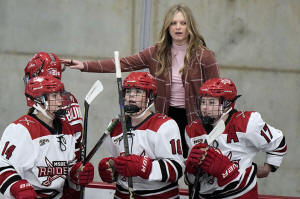Higher interest in youth level
leading to rapid increase of Division III women's hockey programs
[March 12, 2025]
By STEVE MEGARGEE
MILWAUKEE (AP) — When Baylee Marabella got interested in ice hockey
while growing up in Wisconsin, she had to play alongside boys up
until high school because she couldn’t find a girls team in her
area.
That isn’t as much of a problem in hockey hotbeds such as Wisconsin
anymore with a steady increase in the number of girls playing the
sport. That trend helped launch the coaching career of Marabella,
who was known as Baylee Wellhausen when she played on three Frozen
Four teams with Wisconsin from 2014-18.
Marabella now coaches Milwaukee School of Engineering, which just
finished its inaugural season in Division III competition. It’s one
of more than two dozen D-III schools to start women’s hockey teams
over the last decade, capitalizing on the relative lack of cost
compared to doing so in Division I.
“It’s incredible,” Marabella said of the rapid growth.
MSOE was one of 78 schools to play women’s ice hockey this year at
the Division III level, which doesn't offer athletic scholarships.
That represents a 50% increase from 2015, when there were 52 schools
playing the sport at this level.
Marabella believes those numbers can keep going up.
“There’s going to be more and more girls who want to play college
(hockey), so as we keep moving forward, the demand is going to be
higher,” Marabella said.

On the rise
Women’s hockey in North America is on the rise and not only at the
Division III level. The Professional Women’s Hockey League is two
months from completing its second season amid signs that attendance
is up. The six-team league is drawing an average of 7,300 fans this
season – up from 5,500 last year – and might expand by as many as
two franchise next season.
USA Hockey had 73,083 registrations among girls in 2023-24, a 47.4%
increase over its 2013-14 total (49,587). Boys registrations
increased by 4.8% over the same time, from 302,303 to 316,737.
“Overall, the skill level has gotten so much better over the years
that it becomes one of those sports that was almost a no-brainer to
be adding at the Division III level,” said Joe Cranston, who coaches
defending champion Wisconsin-River Falls, which hosts the D-III
championship March 28-30. The 12-team tournament begins Saturday on
campus sites.
Cost differences at bigger programs
There are 44 women's hockey programs in Division I and Division II,
a 12.8% rise from 2015 (39). The two divisions compete in a single
national tournament, which ends this year with the Women's Frozen
Four March 21-23 in Minneapolis.
The modest growth at the higher level can be blamed on the bigger
costs with adding a D-I program. Ice availability is a factor for
any team at any level, and setting budgets is difficult for any
athletic director dealing with the NCAA House settlement and name,
image and likeness compensation questions.
Minnesota reported operating expenses of a little over $3.6 million
for women’s hockey in 2023-24. Michigan released a feasibility study
saying expenses would run about $4.5 million annually if it started
a women’s hockey program.
By contrast, Wisconsin-River Falls reported $197,087 in women’s
hockey expenses in its 2024 Equity in Athletics Disclosure Act
survey.
Michelle McAteer has a unique perspective, as a new commissioner of
a Division I conference (the Western Collegiate Hockey Association)
who finished a 14-season run coaching Division III program Augsburg
last year.
“Hockey’s an expensive sport to operate, and to operate a rink is an
expensive investment,” McAteer said. “At the Division III level, not
everyone has their own rinks on campus. You can get by playing in
community rinks and renting. The facility demands at the Division I
level are quite different. The investment and infrastructure are a
lot more. Everything is more. They have more significant travel.
They have a more significant equipment budget, the staffing
differences.”
[to top of second column] |

Milwaukee School of Engineering head coach Baylee Marabella, top,
reacts during a women's Division III NCAA college hockey game
against Wake Forest College, Friday, Feb. 14, 2025, in Milwaukee.
(AP Photo/Morry Gash)

There’s probably enough talent nowadays to
accommodate more Division I programs. The difference is apparent on
the ice.
“Ten to 12 years ago, there were a lot of teams at the Division I
level that might have had one good line, a line-and-a-half, maybe
two,” said coach Mark Johnson, whose Badgers have been the
top-ranked team in women's hockey most of the season. “Now
everybody’s got two or three lines, maybe four lines, that can
compete and play at a real high level.”
Because the schools in larger divisions haven’t added women’s hockey
programs at a rate that correlates with the growth in the sport at
the youth level, it’s created more opportunities for Division III
schools.
“I have kids on my team who were All-Americans 15 years ago who
couldn’t make my team now,” Cranston said. “Kids who were Division I
players 10 years ago who couldn’t make my team now.”
More talent leads to more parity
Plattsburgh State won five titles in a six-year stretch from
2014-19, but there’s been a different champion for each of the last
five tournaments.
Norwich won in 2018, Plattsburgh State in 2019, Middlebury in 2022,
Gustavus Adolphus in 2023 and Wisconsin-River Falls last year. There
were no Division III championships in 2020 or 2021 due to the
pandemic.
“Most years there’s maybe three or four teams that could win it
all,” Cranston said. “I think this year there’s probably twice that,
probably seven or eight teams that could win the whole thing.”
SUNY Oswego athletic director Wendy McManus, the head of the NCAA
Division III women’s hockey committee, says smaller schools will
continue adding the sport as long as youth participation stays
strong.
“I do think eventually it will level off,” McManus said. “I say that
because you don’t see California schools or true West Coast schools
playing hockey that much. We say ‘West’ is basically Minnesota,
Wisconsin.”
That growth has provided welcome opportunities that might not have
been available a decade earlier.
For instance, MSOE’s roster includes forward Hannah Baumann of
Wausau, Wisconsin, who said she grew up idolizing Marabella and was
a big Badgers fan. Baumann used to have to drive an hour to practice
because of the relative lack of girls hockey teams.

There now are more girls teams than ever, and some gather in the
stands for MSOE’s home games. That has particular meaning for
forward Helen Bechthold, who grew up in the Milwaukee area playing
for one of those youth programs.
“It’s cool to see they have all-girls teams playing now, because
when I was playing, they didn’t have all-girls teams,” said
Bechthold, who grew up playing with boys. “It’s great to see. A lot
of them were like, ‘You played where we play’ and stuff like that.
That definitely makes me happy. I’m happy they have that
opportunity.”
___
AP Sports Writer Dave Campbell and AP Hockey Writer John Wawrow
contributed to this report.
All contents © copyright 2025 Associated Press. All rights reserved |